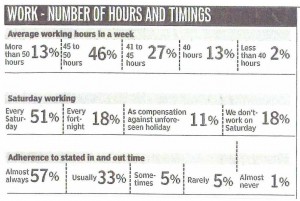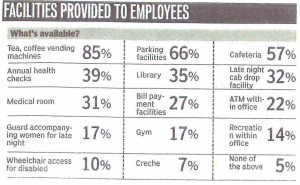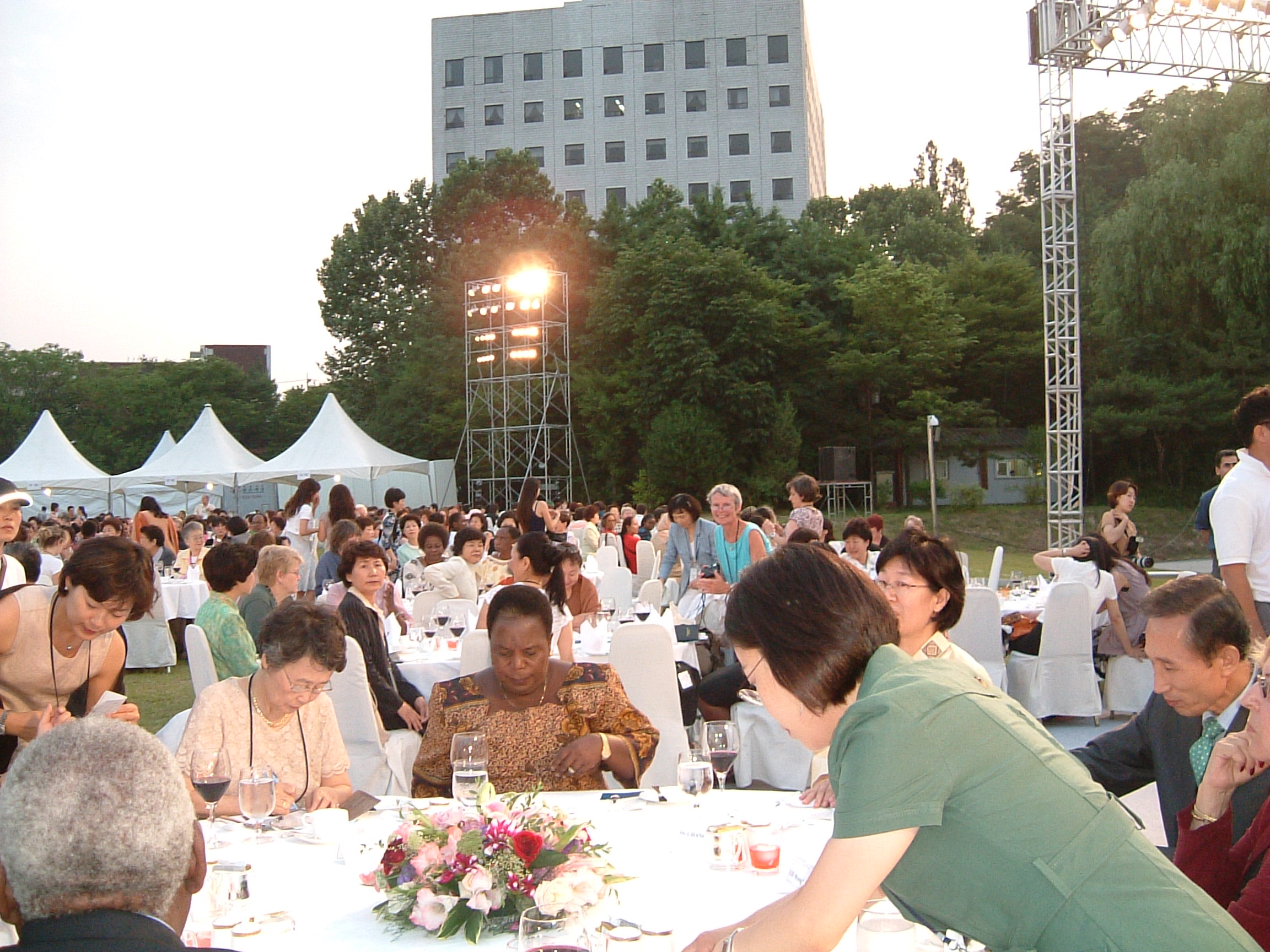Travel Report from India (4) Indian working women
2014/10/23
umbers of Indian working women

Indian firms yet to value women Hindustan Times March 6, 2012,
The exact number of the working women in India is not yet known. A government investigation in 2001 made special efforts to determine the actual number of working women. However, it was very difficult to assess and obtain accurate figures because the labors of women and girls engaged in housework (agriculture) among families were not included in the investigation (*Families think it is a status symbol to shut a woman in the home), and figures for farm villages were especially difficult to obtain. But the number of the working women in urban areas is clear, based on the statistics obtained by the Department of Employment, Education, Training and Public (March, 2004). Statistics show that the numbers of working women are considerably fewer (18.7%) than men, as a representation of the whole organizational sector.
Distinction by industry shows that women are employed in; 55.6% in the service sector, 21.4% in the production sector, 9.8% in agriculture and associated sectors, and 9.49% in finance, real estate, and business sector. However, there is the viewpoint that the advancement of women will increase in future, mainly in the IT sector. According to findings from the Sociology Research Institute in New Delhi (June 6, 2008 http://indonews.jp/mt/mt-tb.cgi/4020), 90% of IT companies introduce flextime, and 59% give women a choice of “tele-working”, and it highlighted that a company takes into consideration the needs of working women. For working women, this activity is expected to have a big effect in the IT industry, and the ratio of working women will soon occupy 30% of the workforce, with this figure expected to increase to 45%, by 2010.
However, many women are not required to have high skills, and it is clear that their jobs focus on simple task-related skills, such as customer reception duties, sales campaign skills, telephone skills, and similar tasks. This continues to make a difficult situation for women.
Number of hours worked by working women
In recent years, working women in India have been spending an increasing amount of time in the workplace. On March 6th 2008, an Indian Chamber of Commerce meeting showed findings that women were spending prolonged hours in the workplace with an average of 60 hours per week, in comparison with just 48 hours three years earlier.

Figure 1 Hindustan Times(March 6, 2012)
Association chairperson, Mr. Venugopal Dhoot, said (March 6, 2008) that the reason for women’s extended working hours was that it was easy to receive support from a husband and the husband’s extended family system which still remains in India, and it is easy for working women to adapt naturally to the working environment. For working women, there is strong support in the big family system that a family supports takes for granted. But is it good for women? I doubt it. They will likely be required to work terribly long working hours. It was stated that, “there is a tendency for women’s working hours to be getting longer, both in government offices as well as in private enterprise ” .
Industrial sectors where working hours of women extends for a long time, are those such as aviation, the media, customer services, banking, and retailing. Information technology occupies the first on the list. The investigation said (March 6, 2008) in future as women occupy places in the workforce measures must be quickly set in place and to ensure safety.
According to the Hindustan Times (March 6, 2012), 13% of companies have increased working hours to more than 50 hours, 46% to 45-50 hours, and 27% to 41-45 hours. In total, 86% of companies become more than 40 hours. In one week, long working hours become open ended. In addition, working on Saturday exceeds 51.5%.
Facilities Provided to Employees
According to data in Figure 2 (below), 39% of companies provided “an annual medical / health Check” and 31% provided a “Medical room”, 17% provided “Guards to accompany women home on late nights” a Gym is provided in17%, and a Cafeteria is provided in 57% of companies.

Figure 2 Hindustan Times (March 6, 2012)


Figure 3 Hindustan Times (March 6, 2012)
Interesting data on corporate meetings shows that time is not kept in India, as investigated by HT Shine (March 6, 2012). (see Figure 3). Based on the question “Do official corporate meetings start on time?”, responses showed that; “2% are almost always and usually”, 13% are “sometimes”, 44% are rarely, and a huge, 39% are almost never”.
Indian companies do not yet elevate women
It has been said that the glass ceiling seems to be set far too high for women managers and team leaders to reach with only 10% in India, compared to 50% of establishments around the world.
Ms. Yandana Ramnani (Hindustan Times, March 6, 2012) wrote this article. Women around the world have shared the podium with men in almost all fields – they have ruled nations, travelled to outer space, and made major business decisions. Corporate India, however, falls well short of the global benchmark. It can be seen that women have not yet broken through the glass ceiling in India; they have not even begun to scratch the surface for that matter.
According to the HT Shine HR Summit Survey conducted by Absolute Data (March 6, 2012), the glass ceiling continues to be too high for most women. About 50% of the organizations polled, revealed that less than 10% employed women managers and team leaders. Almost 25% of organizations have a balanced representation with 50% or more women managers, 9% have no female managers in their workplace. Interestingly, it is the small and medium organizations that have more middle to senior female employees compared to large farms.
It is sad but true, gender stereotyping is still prevalent throughout India. “Indian women have to try twice as hard as men to prove themselves in the workplace. The problem is that they are either too aggressive or too emotional,” says Rekha Sethi, Director General of the All India Management Association.
Some industry sectors in India do not employ many women namely; real estate, liquor (though Diageo is an exception), tobacco infrastructure, energy, mining, and shipping.
Most women have to perform at least two full-time jobs; one in their professional capacity at work and the other is that of a homemaker, of which parenting is a major component. Therefore, industries that require extended travel or the necessity to relocate to areas that do not support their family circumstances are not attractive employment options for women. In some industries, the work environment at the start of the ladder is relatively low for women – unfriendly, either by attitude or in terms of infrastructure”, observes Sonal Aggarwal, CEO of the Accord Group India.
This is corroborated by the HT Shine Summit Survey (March 6, 2012), which shows that only 7% of organizations provide facilities such as creches for women with small children. Safety is an issue too, with just 32% of companies having late night guards to accompany women home at night after they finish their work shift (Vandana Ramnani).
The Indian caste system is gradually dismantling
In India, the Hindu religion currently represents approximately 82% of the population. Originally the caste system comes from Hinduism, and a division of it is called “Jati”, which is the class system according to one’s occupation (social discrimination position), and there are between 2000 and 3000 or more kinds of rankings. As another type of caste system, “Jati” exists depending upon the type of job, and it cannot be eliminated. Therefore after Independence, the government prohibited caste discrimination in the Indian constitution however it still remains today.
At present, new types of industries such as IT companies, BPOs (Business Process Outsourcing), and call centers are developing, and increasing in number. This industry change seems to be advancing in the direction of gradually dismantling the Caste and Jati systems. Once upon a time, working women could only be found working at a hotel reception or in downtown toilet rooms, but recently, we can find women working across every type of industry sector and in all working fields.
Internationally, it is questioned whether India will push its way up to become another major economic power or not?
Well, based on observations during my recent travels there, it is charged with the energy of smart, young women who might break through the caste system and the glass ceiling entirely. I met many such women when I was there.
Translation edit by John Andrews
関連記事
-

-
ミモザとローマのプリマヴェーラ(春)
イタリアの春は、最初に花をつける黄色いミモザの花束とともにやってくる。3月8日の …
-

-
今年の風、どこへ向かってー2021年の重大ニュースより
2022年が明けて10日経ちました。コロナウイルスはさらに変異を遂げて拡大中です …
-

-
中欧の旅 ⑤ ドナウの真珠─クルーズ
ハンガリー人の黒髪、黒い瞳は欧州で唯一のアジア系民族(マジャール人)を表していま …
-

-
ソウル会議がありました
ソウルで開催された「Women’s World‘05」(6/19~24)国際会議 …
-

-
『ヴァラドンとユトリロ 母と子の物語』展
シュザンヌ・ヴァラドン(1865~1938)と息子モーリス・ユトリロ(1883~ …
-

-
もっと知りたいビルマ、6月19日はスーチーさんの日
NHK国際放送局の取材を受けました。テーマは「働く女性と過労死」というブッソウな …
-

-
Travel Report from India (1)
Japanese(日本語) Holi Festival I visited De …
-

-
サンフランシスコ報告 その2
今回は第2回目です。 スタディツアーでサンフランシスコに行きました。コミュニティ …
-

-
サンフランシスコ報告 その1
女性と仕事研究所ではスタディツアーでサンフランシスコに行きました(09年9月7日 …
-

-
アジア(日・中・韓)女性フォーラムに参加しました その2
お茶 お茶のセレモニーがありました。ゆったりしているので、大阪人には少しまどろっ …
- PREV
- インド紀行 その3 ~インドの女性とジェンダー
- NEXT
- インド紀行 その4 ~インドの働く女性